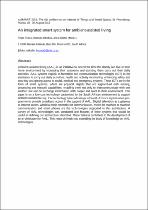JavaScript is disabled for your browser. Some features of this site may not work without it.
- ResearchSpace
- →
- Research Publications/Outputs
- →
- Conference Publications
- →
- View Item
| dc.contributor.author |
Foko, Thato E

|
|
| dc.contributor.author |
Dlodlo, N

|
|
| dc.contributor.author |
Montsi, L

|
|
| dc.date.accessioned | 2013-10-30T06:56:37Z | |
| dc.date.available | 2013-10-30T06:56:37Z | |
| dc.date.issued | 2013-08 | |
| dc.identifier.citation | Foko, T.E., Dlodo, N. and Montsi, L. 2013. An integrated smart system for ambient-assisted living. In: ruSMART 2013: The 6th conference on Internet of Things and Smart Spaces, St. Petersburg, Russia, 28 - 30 August 2013 | en_US |
| dc.identifier.uri | http://link.springer.com/chapter/10.1007%2F978-3-642-40316-3_12 | |
| dc.identifier.uri | http://hdl.handle.net/10204/7021 | |
| dc.description | ruSMART 2013: The 6th conference on Internet of Things and Smart Spaces, St. Petersburg, Russia, 28 - 30 August 2013. Published by Springer | en_US |
| dc.description.abstract | Ambient-assisted living (AAL) is an initiative to extend the time the elderly can live in their home environment by increasing their autonomy and assisting them carry out their daily activities. AAL systems exploit information and communication technologies (ICT) in the assistance to carry out daily activities, health and activity monitoring, enhancing safety and security and getting access to social, medical and emergency systems. These ICTs are in the form of smart systems, which are physical objects that are augmented with sensing, processing and network capabilities, enabling them not only to intercommunicate with one another, but also to exchange information with people and react to their environment. This paper is on a low-cost technology customised to the South African environment to support ambient assisted living. The technology takes advantage of South Africa’s digitalisation programme to provide broadband access in the support of AAL. Digital television as a gateway to internet access, wireless mesh networks for communication, motes for machine to machine communication and smart phones are the technologies supported in this architecture. A survey of AAL technologies was conducted and features of these systems that would be useful in defining our architecture identified. These features contribute to the development of an architecture for AAL. This research feeds into extending the body of knowledge on AAL technologies. | en_US |
| dc.language.iso | en | en_US |
| dc.publisher | Springer | en_US |
| dc.relation.ispartofseries | Workflow;10950 | |
| dc.subject | Smart systems | en_US |
| dc.subject | Ambient-assisted living | en_US |
| dc.subject | AAL | en_US |
| dc.subject | Intelligent environment | en_US |
| dc.subject | Emergency case prediction | en_US |
| dc.subject | Wireless mesh networks | en_US |
| dc.title | An integrated smart system for ambient-assisted living | en_US |
| dc.type | Conference Presentation | en_US |
| dc.identifier.apacitation | Foko, T. E., Dlodlo, N., & Montsi, L. (2013). An integrated smart system for ambient-assisted living. Springer. http://hdl.handle.net/10204/7021 | en_ZA |
| dc.identifier.chicagocitation | Foko, Thato E, N Dlodlo, and L Montsi. "An integrated smart system for ambient-assisted living." (2013): http://hdl.handle.net/10204/7021 | en_ZA |
| dc.identifier.vancouvercitation | Foko TE, Dlodlo N, Montsi L, An integrated smart system for ambient-assisted living; Springer; 2013. http://hdl.handle.net/10204/7021 . | en_ZA |
| dc.identifier.ris | TY - Conference Presentation AU - Foko, Thato E AU - Dlodlo, N AU - Montsi, L AB - Ambient-assisted living (AAL) is an initiative to extend the time the elderly can live in their home environment by increasing their autonomy and assisting them carry out their daily activities. AAL systems exploit information and communication technologies (ICT) in the assistance to carry out daily activities, health and activity monitoring, enhancing safety and security and getting access to social, medical and emergency systems. These ICTs are in the form of smart systems, which are physical objects that are augmented with sensing, processing and network capabilities, enabling them not only to intercommunicate with one another, but also to exchange information with people and react to their environment. This paper is on a low-cost technology customised to the South African environment to support ambient assisted living. The technology takes advantage of South Africa’s digitalisation programme to provide broadband access in the support of AAL. Digital television as a gateway to internet access, wireless mesh networks for communication, motes for machine to machine communication and smart phones are the technologies supported in this architecture. A survey of AAL technologies was conducted and features of these systems that would be useful in defining our architecture identified. These features contribute to the development of an architecture for AAL. This research feeds into extending the body of knowledge on AAL technologies. DA - 2013-08 DB - ResearchSpace DP - CSIR KW - Smart systems KW - Ambient-assisted living KW - AAL KW - Intelligent environment KW - Emergency case prediction KW - Wireless mesh networks LK - https://researchspace.csir.co.za PY - 2013 T1 - An integrated smart system for ambient-assisted living TI - An integrated smart system for ambient-assisted living UR - http://hdl.handle.net/10204/7021 ER - | en_ZA |






